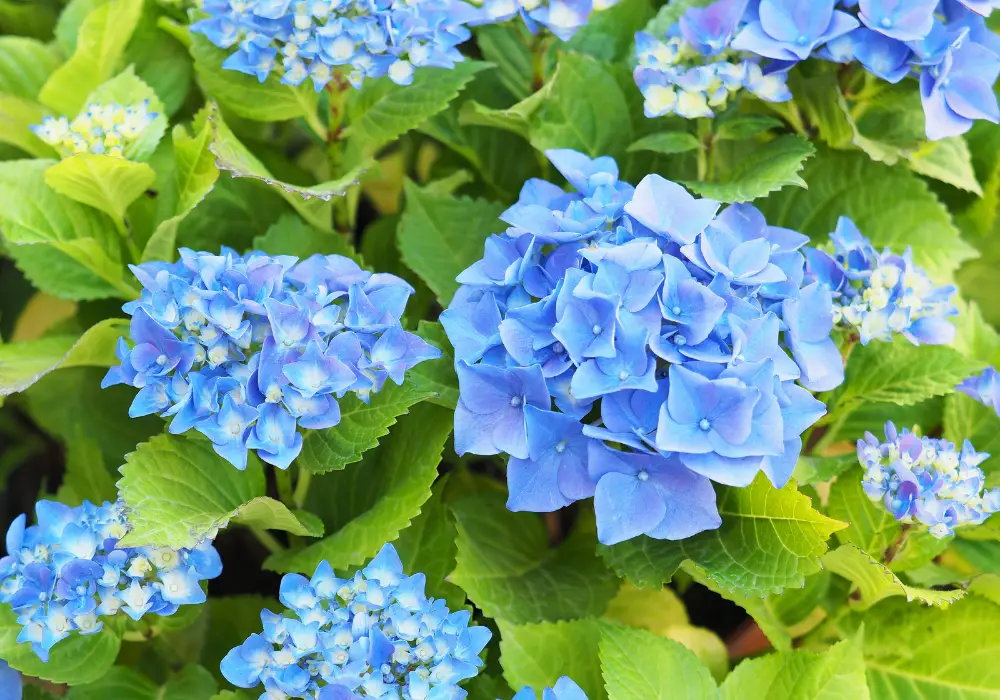Few sights rival the captivating allure of a Nikko Blue Hydrangea in full bloom. its spectacular clusters of blue flowers that look like clusters of sapphires make an interesting addition to any garden. this article delves into the exciting world of these hydrangeas providing a comprehensive guide to growing and celebrating their extraordinary beauty.

Botanical Bliss: Unveiling the Nikko Blue Hydrangea
Nikko blue hydrangeas is a beautiful plant that is part of the hydrangeas macrophylla family .it grows in Japan and is a bushy small plant .it is famous for its magnificent fragrant flowers which are composed of sterile florets. This plant is loved by gardeners all over the world.it can grow 6-10 feet tall and broad and looks beautiful from summer to fall.
check out Nurturing Elegance: Hydrangea Care Tips
Planting Prowess: Cultivating the Perfect Habitat
Nikko Blue Hydrangeas thrive in environments that mirror their Japanese origins. Ideally, provide them with:
- Partial shade: While they tolerate morning sun, afternoon shade is crucial, especially in warmer climates.
- Moist, well-draining soil: Rich, organic soil with excellent drainage is key. Amend clay soils with compost or sand to improve drainage.
- Acidic to slightly acidic soil (pH 5.0-6.5): This magic range unlocks the coveted blue blooms. Alkaline soil fosters pink flowers.
check out Unique Ideas for Round Garden Beds Using Recycled Materials
Nurturing Nirvana: A Guide to Care and Maintenance
Once planted, your Nikko Blue Hydrangea embarks on a journey of exquisite growth with proper care:
- Watering: Consistent moisture is vital, especially during hot weather. Aim for 1 inch of water per week, delivered directly to the base of the plant.
- Fertilizing: Apply a slow-release fertilizer formulated for shrubs and trees in early spring. Organic matter can be used as an alternative.
- Pruning: Prune minimally, if at all. The key is to avoid late summer pruning, as flower buds form then. Remove dead or diseased branches anytime.
A Symphony of Color: Unlocking the Secrets of Blue Blooms
The captivating blue hue of Nikko Blue Hydrangeas is a testament to the magic of soil pH. Acidic soil (pH 5.0-6.5) coaxes out the coveted cerulean tones, while alkaline soil (pH 7.0+) favors pink blooms. To achieve the desired color:
- For blue blooms: Amend the soil with aluminum sulfate, sphagnum peat moss, or coffee grounds to lower the pH.
- For pink blooms: Add lime or wood ash to raise the pH.
check out Exploring Blue Floral Diversity
Nature’s Canvas: A Celebration of Pruning and Design
Nikko Blue Hydrangeas, with their naturally graceful form, require minimal pruning. However, strategic snips can enhance their beauty:
- Remove spent flower heads in late fall or early winter to encourage new growth.
- Prune to maintain desired size and shape but avoid drastic cuts. Remember, they bloom on old wood.
These versatile shrubs can be incorporated into various landscape designs:
- Specimen plants: Let their individual brilliance take center stage.
- Foundation plantings: Add a touch of elegance to your home’s exterior.
- Mixed borders: Create a tapestry of color and texture alongside other shrubs and perennials.
A Toast to Triumph: Overcoming Common Challenges
While generally low-maintenance, Nikko Blue Hydrangeas may face occasional challenges:
- Botrytis blight: This fungal disease attacks flower buds. Improve air circulation and avoid overhead watering to prevent it.
- Leaf spot: Fungal or bacterial leaf spots can mar the foliage. Prune affected leaves and applied fungicide if necessary.
- Pests: Aphids, scales, and slugs can occasionally infest the plant. Use insecticidal soap or neem oil for organic control.
By understanding these potential issues and taking preventive measures, you can ensure your Nikko Blue Hydrangeas thrive for years to come. Read more
Conclusion: A Tapestry of 💙 and Knowledge
Niko blue hydrangeas cultivation is a journey into a botanical miracle. with this comprehensive guide you can navigate this journey with confidence as you unlock the secrets to nurturing these fascinating flowers. So, embrace the magic of these botanical gems, and let their otherworldly beauty grace your garden with a touch of cerulean serenity.
Pingback: How to Grow and Care for French Hydrangeas Gardeners School